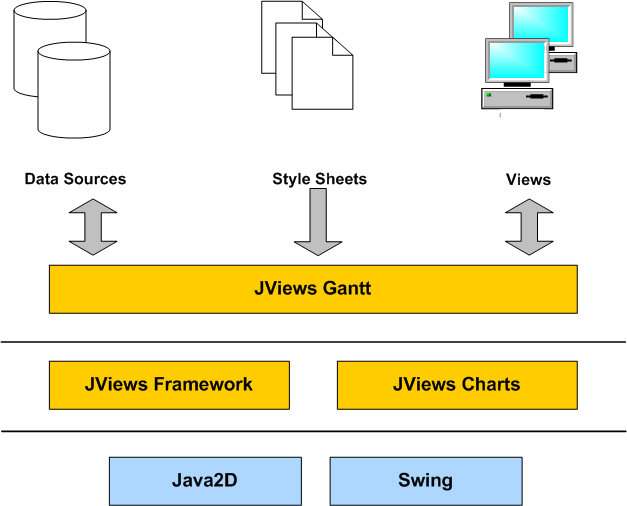SDKs
JViews Gantt architecture is multi-layered. Each layer provides a specific set of services for developers during the development cycle.
JViews Gantt implements a Swing-like model-view architecture, which provides a clear separation between data and its presentation.
The data model is the central piece that is connected to the actual application data. All operations, whether user interactions or data changes, are performed on the data model and dispatched to the views. Developers can choose to load the data model with data fetched from the original application data, in which case the data is somehow duplicated. Alternatively, the data model is an interface that can be tightly plugged to the actual data without any data duplication.
The look and feel of the Gantt chart is determined by style sheets (CSS) that can be created with the Designer or written manually. In both cases, the information that determines the look and feel is extracted from the Java code, which allows for easier customization of the final application. Using style sheets is optional. The SDKs can be used instead.
The JViews Gantt SDK includes all the Java API required to parameterize the Gantt chart views, the Gantt data model, and the interaction capabilities. It also provides APIs for printing and deploying as a thin client.
The JViews Gantt SDK depends on the SDKs of JViews Framework and JViews Charts.
JViews Framework defines the structured 2D graphics layer above Swing and Java 2D™. JViews Framework is used in specific situations where the JViews Gantt SDK needs to be extended, such as when you need to create new activity renderers and new interactors.
JViews Charts defines a business charting layer above Swing and Java 2D. The JViews Charts SDK is used when you need to customize the appearance of Resource Load charts.
Copyright © 2018, Rogue Wave Software, Inc. All Rights Reserved.
